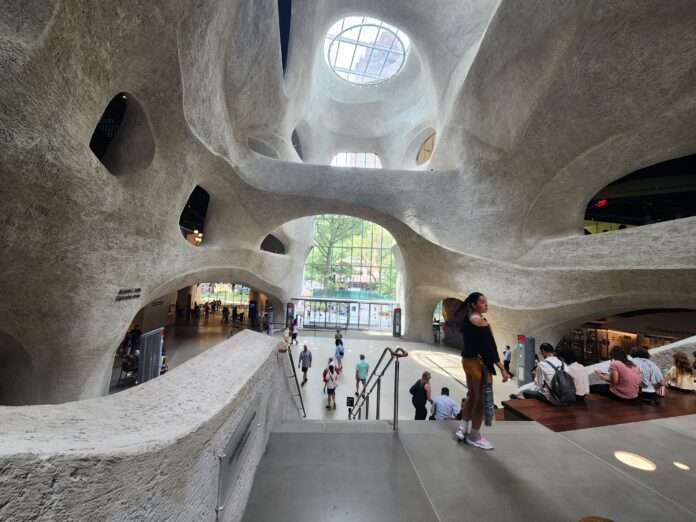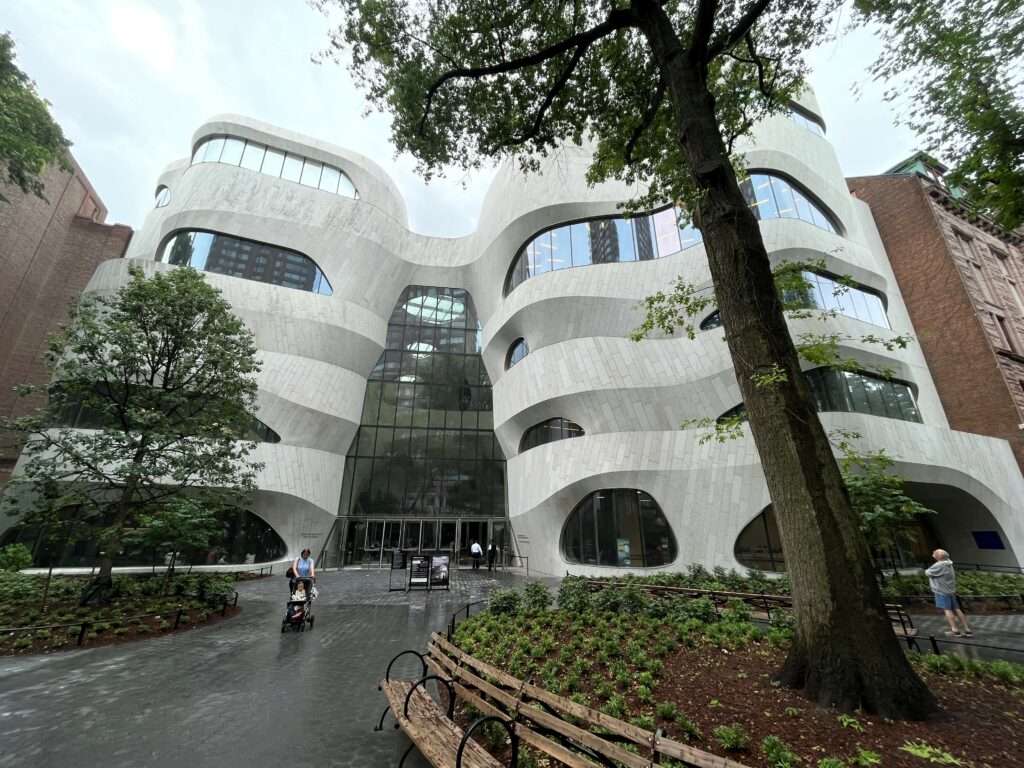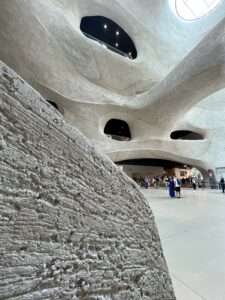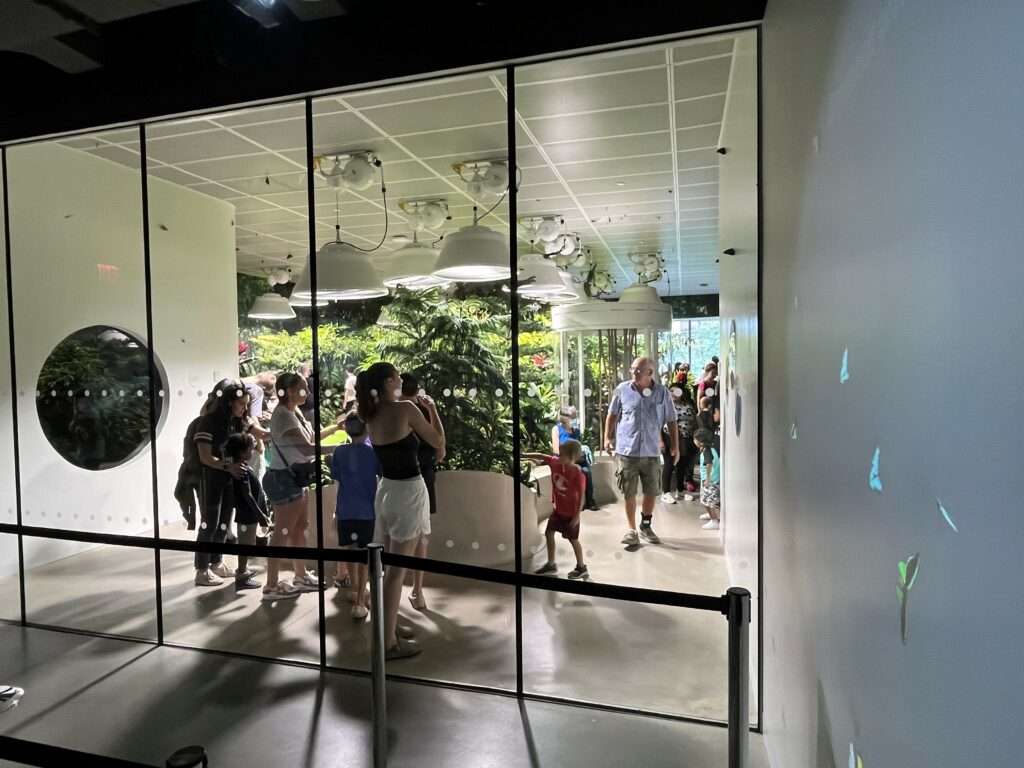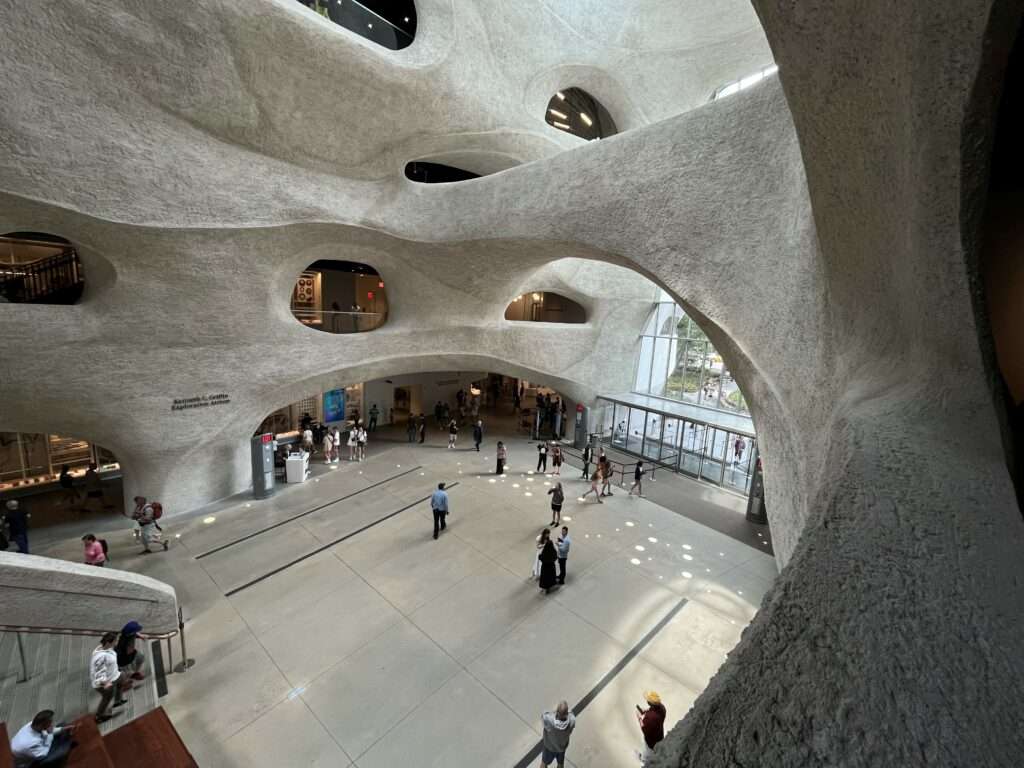COST of Wisconsin blends art and engineering to help create new Gilder Center at AMNH
by Martin Palicki
It’s rare that a building’s design can become so immediately iconic – an attraction unto itself. Gaudi’s Sagrada Familia in Barcelona comes to mind. It is a visual feast – a sculpture that takes the shape of a building. Many architecture critics are already claiming the same for the newly opened Gilder Center at the American Museum of Natural History (AMNH) in New York City. Officially named the Richard Gilder Center for Science, Education, and Innovation, the addition to AMNH is the icing on a very prestigious cake. AMNH boasted five million visitors in 2019 (the most recent year the TEA/AECOM Theme Index ranked museums). It is the ninth most-visited museum in the world, and in North America it is second only to the Metropolitan Museum of Art (also in New York City).
The Gilder Center is a 230,000 sq-ft addition that boasts 33 individual connections across four levels to 10 other buildings on the AMNH campus. In addition to helping unify the museum, Gilder houses impressive exhibits including an insectarium, the Davis Family Butterfly Vivarium, new collection displays and the immersive Invisible Worlds experience, a projection-mapped environment that takes guests to scientific and natural realms nearly impossible to see under normal circumstances.
Also capturing attention, of course, is the building itself. Designed by Studio Gang, the building is curvaceous and flowing, or in architect-speak, it’s nonrectilinear. The west- facing exterior features glass windows peeking out from undulating smooth pink granite forms. The 80-foot-tall interior atrium lobby, evocative of a canyon, is made from a material that coats nearly every surface, applied in novel ways. Openings into exhibit spaces and bridges spanning the atrium are amorphous – no shape is repeated in the design. The finish is off-white, and although the primary material is concrete, the effect is organic, almost like looking at bone on a microscopic level, with its crevices and tendons stretching across the space.
The skills to build
Coming up with a design of this order requires very specific talents, but figuring out how to build it is another skill entirely. Construction manager and general contractor AECOM Tishman turned to contractor COST of Wisconsin to help create the building – and the construction means and methods. They tasked COST with a unique design-assist role. Instead of just taking plans and building them, COST played a critical part in the team determining – or assisting in – how the architect’s vision would be achieved.
Based in Jackson, Wisconsin with offices in Orlando, FL and Berryville, AR, COST has been providing theme and specialty construction services for projects around the world since 1957. Though their work can be seen in everything from commercial, recreational and residential environments, they are perhaps best known for their work in themed attraction spaces. In fact, the company was founded to create realistic animal habitats at the Milwaukee County Zoo at a time when animal enclosures were being reconceived to be less like cages and more like natural environments. COST is known for attention to detail in its fabrication and recent projects include work on Lost Island Theme Park, Meow Wolf Convergence Station (Denver) and the Cincinnati Zoo: Hippo Cove, home to the world-famous hippo Fiona.
Gilder provided an opportunity for COST to showcase their skills beyond decorative theming, bringing together design, engineering, fabrication and artistry in new ways. “We were so excited to be part of the team creating this epic project that will be around for generations to come,” said Jeff Sheiber, VP of Sales for COST. “We are thankful the American Museum of Natural History, AECOM Tishman and Studio Gang trusted that we had the unique skillsets needed to achieve their vision.”
Fabrication innovation
The vision and mandate were clear: create a building with almost no straight lines or right angles where no shapes are repeated. Oh, and no visible seams either.
“The museum and designers knew the shape of what they wanted for the building, but they weren’t exactly sure how it could be done,” said COST of Wisconsin senior project manager Sergio Castro. “It was a real collaboration of minds between the engineering group, the museum, the construction managers and us at COST Inc.”
The design team determined that traditional formwork would not be appropriate for the project. That method typically relies on concrete being poured into plywood forms, which are difficult to make into smooth, rounded shapes. The solution was to use shotcrete, a well-established method of spraying a cementitous mixture onto a rebar cage. Shotcrete is commonly used for curved tunnel walls. It’s also used for decorative rockwork, such as in theme parks or animal habitats. But the Gilder application had to function as a mix between the two. The shotcrete had to provide the structural support of a tunnel wall, as well as the aesthetic style and finish of decorative rockwork. COST’s extensive experience with shotcrete was the perfect fit for the project.
As a proof-of-concept, COST fabricated a sample for the general contractor and Studio Gang to examine. “We created a section of the model at our shop to prove to the team that we were able to execute their vision,” said Castro. “And it worked.”
“We pride ourselves on being able to find new ways to approach problems and to look at the fabrication process in different ways,” said Sheiber. “Gilder shows that with the right approach you can effectively combine constructability, longevity and aesthetics into one process.”
An odyssey of rebar
To create the unique shapes of the structure, COST designed, fabricated and installed custom pipe forms and rebar. The pipe formwork acted as a basic guide and mounting point for rebar, which then got sprayed with shotcrete.
Construction began with conventionally built concrete perimeter columns and floor slabs. Next, over 900 pipe forms were individually designed, fabricated in Wisconsin, identified, shipped and installed via standard surveying methods. The need for 453 tons of rebar (also fabricated in Wisconsin) was extracted from extensive 3D computer models; the rebar was tagged with identifying numbers that coincided with drawings created by COST’s design team. Over 50 semi-trucks traveled from Wisconsin to Brooklyn where a staging yard was set up before pieces were brought on-site for installation.
“Space on the site in the middle of Manhattan was extremely limited,” explained Castro. “The logistics behind bringing components to the site had to be precise. We didn’t have room on- site to store materials, so items had to be brought from the staging yard in a coordinated fashion.”
The pipes were anchored to the slabs, and each individual rebar piece was attached to the pipes. Next, work began on the shotcrete application. Teams worked in sequence, as pipe and rebar sections were completed, shotcrete teams took over and the process continued.
Shotcrete like never before
COST used two different shotcrete mixes for Gilder. The first was a structure coat which gave the building structural stability. It was applied as the first layer over all rebar, as required by the engineer. The structure coat was followed by a finish coat that also produced additional structural qualities for the building but was not required for the building’s engineering.
The application was performed via a shotcrete pump and a certified nozzleman in a preplanned shooting sequence, which was necessary to create the specific aesthetics of the building as required by Studio Gang. The thickness of the finish coat was checked prior to completion, to ensure there was not any additional unintended weight on the building. Once the correct thickness was confirmed, COST used a rough trowel technique to the finish surface to achieve its final look. The white color was achieved through the addition of Type I White cement to the mix. No paints or stains were introduced to the surface.
The exterior of the building was handled a bit differently. There are no perimeter columns for the exterior west-facing wall. Instead, COST fabricated a series of premade rebar panels, rather than individual pieces of rebar as was done for the interior. The shotcrete was applied traditionally and can be seen exposed on the inside of the wall. The exterior surface is covered in granite panels, hung onto metal plates that are embedded into the shotcrete.
“The granite panels had an extremely small tolerance for variance, so the prefab rebar panels we produced back in Wisconsin gave us more control over the geometry and allowed us to easily hang the exterior granite,” explained Castro.
The completed building opened May 4, 2023, and has already captivated museum guests and architecture aficionados alike.
“The finished product shows that COST knows rebar and knows shotcrete and we are able to do just about anything with them,” said Castro. “So often theme park professionals look at these tools and just think of pretty rockwork – which of course they are great for! But the capabilities far exceed beyond architectural theming and can be used in truly innovative ways to build the impossible.” •


